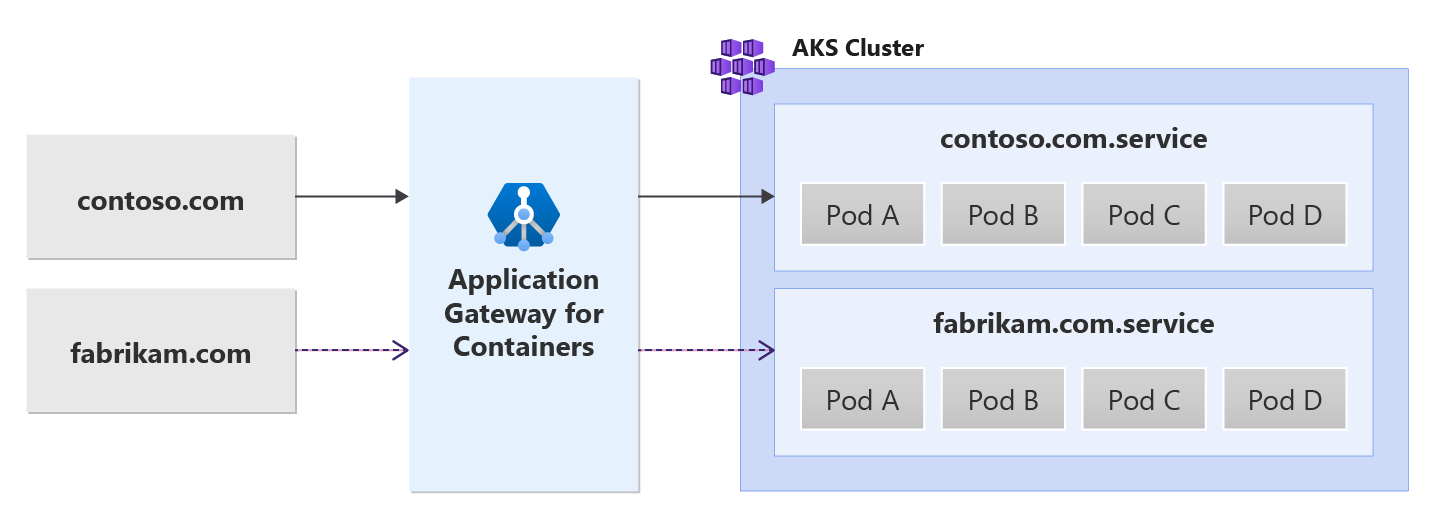컨테이너용 Application Gateway를 사용하여 다중 사이트 호스팅 - 수신 API
이 문서는 수신 API를 사용하여 동일한 Kubernetes 수신 리소스/Application Gateway for Containers 프런트 엔드에서 여러 사이트를 호스팅하는 방법을 보여 주는 예제 애플리케이션을 설정하는 데 도움이 됩니다. 다음 단계가 제공됩니다.
- 두 개의 호스트를 사용하여 수신 리소스를 만듭니다.
배경
컨테이너용 Application Gateway를 사용하면 동일한 포트에서 둘 이상의 웹 애플리케이션을 구성할 수 있으므로 다중 사이트 호스팅을 사용할 수 있습니다. 고유한 백 엔드 서비스를 사용하여 둘 이상의 고유한 사이트를 호스트할 수 있습니다. 다음과 같은 예제 시나리오를 참조하세요.

필수 조건
BYO 배포 전략을 사용한 경우 컨테이너 리소스 및 ALB 컨트롤러용 Application Gateway를 설정했는지 확인합니다.
ALB 관리 배포 전략을 사용한 경우 ApplicationLoadBalancer 사용자 지정 리소스를 통해 ALB 컨트롤러 및 컨테이너용 Application Gateway 리소스를 프로비전해야 합니다.
샘플 HTTP 애플리케이션 배포:
클러스터에 다음 deployment.yaml 파일을 적용하여 경로, 쿼리 및 헤더 기반 라우팅을 보여 주는 샘플 웹 애플리케이션을 만듭니다.kubectl apply -f https://raw.githubusercontent.com/MicrosoftDocs/azure-docs/refs/heads/main/articles/application-gateway/for-containers/examples/traffic-split-scenario/deployment.yaml이 명령은 클러스터에 다음을 만듭니다.
- 호출된 네임스페이스
test-infra - 네임스페이스에 호출
backend-v1된test-infrabackend-v2두 서비스 - 네임스페이스에 호출
backend-v1된test-infrabackend-v2두 개의 배포
- 호출된 네임스페이스
필요한 수신 리소스 배포
- 수신 만들기
kubectl apply -f - <<EOF
apiVersion: networking.k8s.io/v1
kind: Ingress
metadata:
name: ingress-01
namespace: test-infra
annotations:
alb.networking.azure.io/alb-name: alb-test
alb.networking.azure.io/alb-namespace: alb-test-infra
spec:
ingressClassName: azure-alb-external
rules:
- host: contoso.com
http:
paths:
- path: /
pathType: Prefix
backend:
service:
name: backend-v1
port:
number: 8080
- host: fabrikam.com
http:
paths:
- path: /
pathType: Prefix
backend:
service:
name: backend-v2
port:
number: 8080
EOF
수신 리소스가 만들어지면 상태 부하 분산 장치의 호스트 이름을 표시하고 두 포트가 모두 요청을 수신 대기하는지 확인합니다.
kubectl get ingress ingress-01 -n test-infra -o yaml
성공적인 수신 만들기의 예제 출력입니다.
apiVersion: networking.k8s.io/v1
kind: Ingress
metadata:
annotations:
alb.networking.azure.io/alb-frontend: FRONTEND_NAME
alb.networking.azure.io/alb-id: /subscriptions/aaaa0a0a-bb1b-cc2c-dd3d-eeeeee4e4e4e/resourcegroups/yyyyyyyy/providers/Microsoft.ServiceNetworking/trafficControllers/zzzzzz
kubectl.kubernetes.io/last-applied-configuration: |
{"apiVersion":"networking.k8s.io/v1","kind":"Ingress","metadata":{"annotations":{"alb.networking.azure.io/alb-frontend":"FRONTEND_NAME","alb.networking.azure.io/alb-id":"/subscriptions/aaaa0a0a-bb1b-cc2c-dd3d-eeeeee4e4e4e/resourcegroups/yyyyyyyy/providers/Microsoft.ServiceNetworking/trafficControllers/zzzzzz"},"name"
:"ingress-01","namespace":"test-infra"},"spec":{"ingressClassName":"azure-alb-external","rules":[{"host":"example.com","http":{"paths":[{"backend":{"service":{"name":"echo","port":{"number":80}}},"path":"/","pathType":"Prefix"}]}}],"tls":[{"hosts":["example.com"],"secretName":"listener-tls-secret"}]}}
creationTimestamp: "2023-07-22T18:02:13Z"
generation: 2
name: ingress-01
namespace: test-infra
resourceVersion: "278238"
uid: 17c34774-1d92-413e-85ec-c5a8da45989d
spec:
ingressClassName: azure-alb-external
rules:
- host: contoso.com
http:
paths:
- path: /
pathType: Prefix
backend:
service:
name: backend-v1
port:
number: 8080
- host: fabrikam.com
http:
paths:
- path: /
pathType: Prefix
backend:
service:
name: backend-v2
port:
number: 8080
status:
loadBalancer:
ingress:
- hostname: xxxxxxxxxxxxxxxxxxxxxxxxxxxxxxxx.fzyy.alb.azure.com
ports:
- port: 80
protocol: TCP
애플리케이션에 대한 액세스 테스트
이제 프런트 엔드에 할당된 FQDN을 통해 일부 트래픽을 샘플 애플리케이션으로 보낼 준비가 되었습니다. FQDN을 가져오려면 다음 명령을 사용합니다.
fqdn=$(kubectl get ingress ingress-01 -n test-infra -o jsonpath='{.status.loadBalancer.ingress[0].hostname}')
다음으로 curl 명령을 contoso.com 사용하여 서버 이름 표시기를 지정합니다. 프런트 엔드 FQDN이 backend-v1 서비스에서 응답을 반환해야 합니다.
fqdnIp=$(dig +short $fqdn)
curl -k --resolve contoso.com:80:$fqdnIp http://contoso.com
응답을 통해 다음을 확인해야 합니다.
{
"path": "/",
"host": "contoso.com",
"method": "GET",
"proto": "HTTP/1.1",
"headers": {
"Accept": [
"*/*"
],
"User-Agent": [
"curl/7.81.0"
],
"X-Forwarded-For": [
"xxx.xxx.xxx.xxx"
],
"X-Forwarded-Proto": [
"http"
],
"X-Request-Id": [
"dcd4bcad-ea43-4fb6-948e-a906380dcd6d"
]
},
"namespace": "test-infra",
"ingress": "",
"service": "",
"pod": "backend-v1-5b8fd96959-f59mm"
}
다음으로 curl 명령을 fabrikam.com 사용하여 서버 이름 표시기를 지정합니다. 프런트 엔드 FQDN은 backend-v1 서비스에서 응답을 반환해야 합니다.
fqdnIp=$(dig +short $fqdn)
curl -k --resolve fabrikam.com:80:$fqdnIp http://fabrikam.com
응답을 통해 다음을 확인해야 합니다.
{
"path": "/",
"host": "fabrikam.com",
"method": "GET",
"proto": "HTTP/1.1",
"headers": {
"Accept": [
"*/*"
],
"User-Agent": [
"curl/7.81.0"
],
"X-Forwarded-For": [
"xxx.xxx.xxx.xxx"
],
"X-Forwarded-Proto": [
"http"
],
"X-Request-Id": [
"adae8cc1-8030-4d95-9e05-237dd4e3941b"
]
},
"namespace": "test-infra",
"ingress": "",
"service": "",
"pod": "backend-v2-594bd59865-ppv9w"
}
축하합니다. ALB 컨트롤러를 설치하고, 백 엔드 애플리케이션을 배포하고, 컨테이너용 Application Gateway의 수신 API와 함께 서로 다른 호스트 이름을 사용하여 두 개의 서로 다른 백 엔드 서비스로 트래픽을 라우팅했습니다.